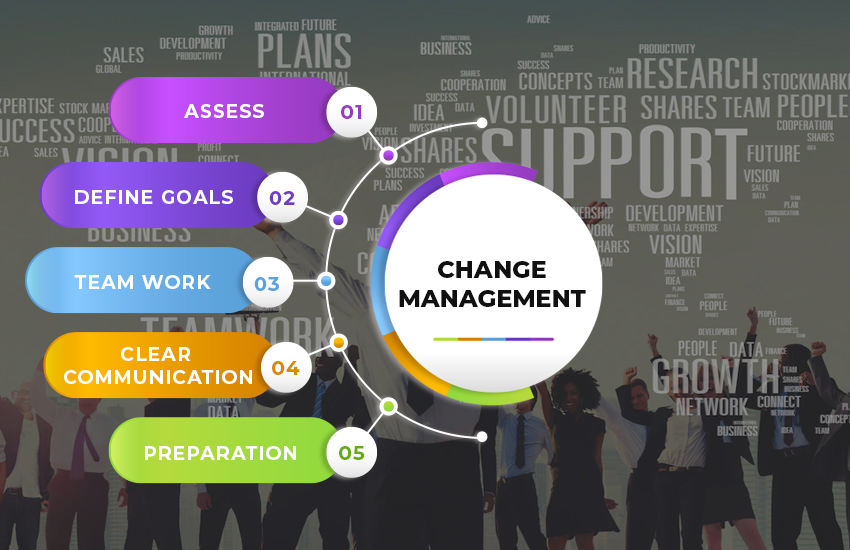The Role of Leadership in Change Management

Based upon our depth of experience working with clients we have found that our clients value working with OpenEyes since we engage in specific discussions to understand their business objectives and facilitate change management initiatives. We do this to ensure that our clients are getting the greatest strategic value from their software creation project.
We also make sure that our clients not only satisfy their immediate business needs that they have identified but are also set up for future benefits that they may not have deeply considered yet. And one of the ways that we do that is by looking at the projects through the lens of change management as it significantly increases the rate of success and future risk reduction in the implementation of projects. We understand that there is a constant need for business organizations to evolve and adapt to keep up with the changing business needs. No business can afford to stand still; there will always be challenges to overcome, learning new and better ways of doing things.
However, managing a successful business transformation and revamping the policies & functions for people depends on how effectively the leaders engage in company culture. Company culture is invisible, but everyone can feel its effect; it is implicit rather than explicit, more emotional, and less rational. To keep up with the constantly evolving business world, leaders often need to implement changes across their company, affecting the people, processes, and products.
However, for employees accepting change is difficult. A cultural change cannot be a top-down mandate from the management. Company culture is the sum of collective habits, shared values, and perception; it’s determined by ‘how things are done in a company’. Significant efforts and strong leadership are essential for cultural, procedural, and technological change. A systematic approach to managing change is essential to developing an agile workplace culture but this is not an easy feat to achieve since people resist change. Proven change management techniques can assist leaders in addressing the people’s side of change and avoid the pitfalls that cause so many change initiatives to fail.
So, let’s look at a few ways business leaders can implement change and manage their business transformation journey.

Accurately assess the current state of the business
As a leader, before you steer your company and employees towards its goals, you must get a sense of where you are coming from and where you intend to go. Think about the following aspects of your business-
- What is the need for change, and what are the critical business objectives?
- How will the company and employees benefit from the proposed changes?
- What will be the impact of change initiatives on people, and how will it affect the way employees work?
- What can employees do to implement the change successfully?
A clear understanding of why the company’s current state needs to change and its impact on business stakeholders, customers, employees, and shareholders is essential to implement sustainable long-term change. Management systems such as a balanced scorecard approach will help to translate strategic business goals into performance objectives. By measuring and monitoring business objectives, leaders can assess whether they have achieved all the strategic goals.
Define your business goals with clarity
Business goals determine the company’s annual and quarterly strategy, market positioning amidst competitors, mission statement, act as a company culture guide, help in accurate financial predictions, and other essential business activities. A clear business goal aligns the company’s vision and mission with its long-term growth objectives.
Clarifying your goal will help you determine the timeline, indicating a starting date and an end date. A goal without a deadline will have no sense of urgency and low motivation to achieve it. Business objectives should be time bound and rolled out in phases. This will help track the work progress, fix issues, and change things if something doesn’t work out.
Change management is a team effort and not a one-person job
Change management relies more on building effective partnerships, systems & processes, and culture rather than depending on a single employee’s talent or experience. Most companies have become interdependent; for example, whether a company is a small business or a global corporation with offices across locations, the disruption caused by the pandemic affected everyone equally.
These interdependencies don’t just apply to things happening outside a company; all organizations are internally interdependent. Most departments are interdependent and changing a process in one department invariably affects all other processes and departments. All these aspects make change much harder to implement and manage. This is why change efforts require continuous collaborative efforts of the entire team.
Frequent and clear communication
During change management, business leaders often focus too much on logistics and processes and not enough on proper communication.
Change management can only be successful and well supported by employees when they understand the purpose, the outcome, and the overall benefits. Without clear, frequent communication, all the change initiatives will likely fail.
However, fruitful conversations about change are challenging. Emotional outbursts and a mindset of resistance can be frustrating. Still, the truth is one cannot just order employees to be enthusiastic about changes in processes, systems, policies, etc. People only take to an idea when they understand its intention and purpose.
A few tips for effective change management communication:
- Communicate frequently, early, and clearly since sudden change is disturbing.
- Communicating through the right people, involving the management and supervisors, is a great idea. Company policies should trickle down from the leadership team to the employees.
- Use multiple communication channels, do not rely on one medium to pass on critical information; instead, use multiple mediums and modes to pass on information to employees.
- Show the benefits to employees, as people like to know ‘what’s in it for me?’ or ‘how does it affect me?’, clarifying these concerns will help to build trust amongst employees and the management team.
Be prepared for resistance
However much you justify the change, there is bound to be some resistance towards it. Employees often have emotional reactions before they accept the change.
Simply announcing the change is not enough. People may need support and handholding to implement the change, as it’s necessary to understand their hesitation and motivation. By being prepared for such emotional reactions, leaders can communicate with empathy with the employees. By understanding the employees’ mindsets, a leader will know how the upcoming change within the company will fit in with employee career goals.
Sometimes employees cannot voice the reasons for their resistance and may not want to be a part of the change process. In such cases, making a tough decision is the need of the hour.
Business leaders need a firm strategy to deal with change resistance. A few ways to get employee buy-in:
- Developing a strong senior and middle management team who supports the need for change. Business leaders should build alliances, focus on business needs and promote wins.
- Training, developing tools and processes for supervisors and managers, leaders should involve them, train them for eventual change, and communicate regularly.
- Training and mentoring employees to help them adjust to the change.
- Having a rewards and recognition program also helps to motivate people.
- Getting help from other subject-matter experts
Our final thoughts
Change Management implements knowledge, tools, and resources to deal with change. Business strategies, structures, procedures, budget allocation, and technologies facilitate change management in a company. Change management goes way beyond project management and technical tasks. Managing the ‘people’ is the most critical part of change management within a company.
Leaders across industries have found that if the employees are left on their own, it has led to costly errors. Moreover, dissatisfied employees are less productive. To facilitate change management, business leaders need a communication plan, a roadmap for key employees who are also changing sponsors, a training program to ensure everyone is on the same page, and a plan to deal with resistance, if any.
Benefits of Change Management Initiatives
Change management initiatives should be planned, timed, and integrated to be successful. Involving the Human Resource team at the onset is essential; they can help in the following ways.
- Communicate with employees to improve their understanding of the change and the entire process
- Ensure frequent and clear communication between the management and the employees
- Identify the business risks and develop a plan to mitigate the risks.
- Make sure that the employees are satisfied and there are no ill feelings.
- Build trust between the leadership team and the employees
- Take training initiatives to improve employee skills and proficiency.
Technology innovation and globalization have resulted in a continuously evolving business environment. Mobile adaptability and social media have changed the way businesses operate. There is a constant need for change and therefore change management. Technology also has an increasing effect on the availability and accountability of knowledge. Information is more readily and easily available, and easy access to information has resulted in unprecedented scrutiny from stakeholders, media, and the public. Due to technological innovation and growth, organizational change is more motivated by external factors than internal factors. Companies that adapt the fastest automatically get a competitive advantage over others. Therefore, managing and adapting to business change is necessary for today’s workplace.
OpenEyes has a depth of experience in helping organizations access and realize the state of their IT operations. Our experienced team of current and former C-suite leaders, decision makers, and other subject-matter experts can advise you. We aim to provide our clients with maximum insight into their business objectives so they can make decisions with confidence.
Get in touch today for strategic due diligence and industry deep dives to win new business, enhance learning and growth.
